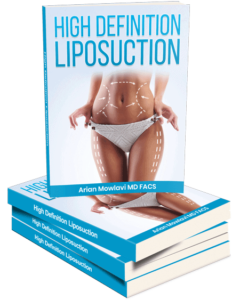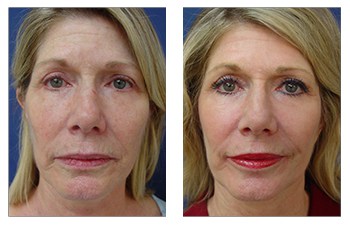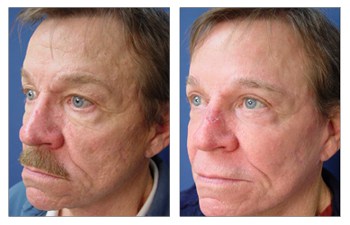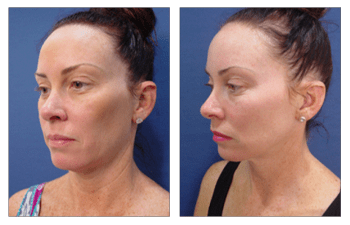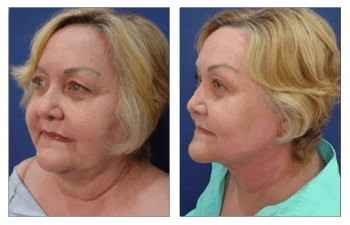WANT THE CONFIDENCE THAT COMES WITH
KNOWING YOU LOOK YOUR BEST?
Facial Resurfacing CASE STUDIES
facial resurfacing Surgery CASE STUDIES
Facial Resurfacing
Laser resurfacing procedures utilize light wavelengths absorbed by specific molecules that exist in the skin. Depending on the wavelength and timing of the light pulse, patients can benefit from either an ablative, sloughing off of skin layers, or a thermal, heating of the underlying collagen, effect.
The ablative power of the laser allows for the improvement of the skin texture including softening of fine wrinkles especially around the mouth, tightening of acne pores, and reviving the sheen of youthful skin.
The thermal component provides heating of the underlying collage which results in tightening of the overlying skin. By performing both simultaneous ablative and thermal pulses, the patient can expect a long-lasting correction of their desired effect.
Laser resurfacing procedures provide a minimally invasive alternative to facial rejuvenation that is ideal for patients who have blemishes, fine wrinkles, aging texture changes of their skin, and minimal sagging of the skin. This procedure can be performed as an in-office procedure avoiding the need for general anesthesia.
This benefit results in a very tolerable surgical and recovery experience. Patients can expect their laser resurfacing to be performed in less than an hour and a full recovery within two weeks. This procedure is performed in thirty and forty-year-olds who may not be ready for the traditional facelift procedure. Dr. Paris currently utilizes two lasers to perform his laser resurfacing procedures and these include: the Erbium and the CO2 fractionated laser systems.
The Erbium laser is intended for patients with finer wrinkles and subtle blemishes who need to have a speedy one-week recovery. The CO2 fractionated laser system is intended for patients who have deeper wrinkles, larger pores, and who possess mild skin redundancy requiring tightening. A complimentary consultation with Dr. Paris will determine which laser system is the best choice for you.
Procedure
Elimination and reduction of fine to medium wrinkles, uneven pigmentation, sun damage, acne scarring, age spots, and other skin problems using
a) Erbium laser or
b) The CO2 laser, which causes thermal damage to unhealthy areas and triggers greater production of collagen to rejuvenate the appearance of the aging face (particularly around the eyes and mouth), neck and hands.
Length
Several minutes to 1.5 hours, depending on the size of the treatment area and the depth of the imperfections.
Anesthesia
For small areas, patients are usually administered a local anesthetic that is sometimes combined with an oral sedative. For facial resurfacing of the entire face, patients are either administered intravenous sedation or general anesthesia.
Place of Treatment
Physician’s office-based facility, outpatient facility or at a hospital
Side Effects
a) Redness: Patients may experience redness for several weeks, or longer, depending on the size of the treated area and method of treatment. The redness will become pink and gradually lighten to your natural skin color over time.
b) Crusting: Immediately after treatment, the skin may appear red or pink and be covered with a fine layer of crust. The crusting usually subsides within 1 to 2 weeks and protective sunblock should be worn at this time.
c) Mild swelling: Mild swelling may occur after treatment and usually subsides within several days to a few weeks.
Risks
a) Infection: Infection may occur after treatment, but is generally avoided by rinsing the skin several times a day with cool tap water. Applying an ointment to the skin or using occlusive dressings to retain moisture in the skin also promotes healing and minimizes the risk of infection.
b) Irregular pigmentation: Some patients may experience hyper-pigmentation (darkening of the skin) or hypo-pigmentation (lightening of the skin) as a result of skin resurfacing. However, skin discoloration has treatments available. Skin discoloration after facial resurfacing may be permanent in some cases, especially when deep laser treatment is required.
c) Burns: Heat from the laser power may cause burns. To minimize the likelihood of burn injuries, patients should follow their physician’s special instructions, such as avoiding unsafe sun exposure before and after treatment.
d) Scarring: Although scarring may occur in some cases, the risk of scarring is very low for facial resurfacing procedures. Furthermore, the appearance of scars can be reduced with skin medication.
Recovery
a) Erbium laser: Patients can usually resume normal activities and return to work between 7 to 10 days after treatment. It may take a few weeks for your skin tone to appear normal.
b) CO2 laser: Patients can usually resume normal activities and return to work within 2 weeks. It should take between 3 to 8 weeks for your skin tone to appear normal.
Duration of Results
Facial resurfacing results generally last for several years, varying upon each patient’s diligence to protect their skin from the sun and maintain a healthy lifestyle. Over time, natural facial movements and expressions will also cause wrinkles to reappear. Patients may require additional facial resurfacing procedures in the future to maintain their rejuvenated appearance.
FREQUENTLY ASKED QUESTIONS
Am I a good candidate for facial resurfacing?
Individuals with facial wrinkles, superficial scars, uneven pigmentation and other cosmetic skin problems may consider facial laser resurfacing to regain a more youthful appearance. Individuals with lighter skin tone, and have limited sun exposure after treatment, typically achieve the best results. Patients with a darker skin tone may be more susceptible to skin pigmentation changes after treatment. Individuals with a history of abnormal scarring, such as keloid or hypertrophic scars, have had bacterial or viral infection of the skin, or have special conditions that could impede the healing process may not be good candidates for facial resurfacing procedures. Patients considering facial resurfacing should be in good general health, both physically and emotionally before pursuing treatment.
What does facial resurfacing involve?
a) CO2 laser facial resurfacing entails the delivery of intense busts of high-powered laser energy to undesired skin tissue. The unwanted skin is vaporized one layer at a time to reveal the fresh, healthy skin underneath. This procedure has a low risk of scarring, causes mild to moderate discomfort, and requires about 2 weeks of recovery time.
b) Erbium laser facial resurfacing delivers a less intense laser energy (compared to the CO2 laser) to the unwanted skin tissue, which minimizes damage to the surrounding skin and reduces the recovery time to about 1 week. The wavelength of light that erbium laser emits gently penetrates the skin, is readily absorbed by water, and reduces the extent of thermal damage created by laser treatment. This method is suitable for patients with mild to moderate facial wrinkles, scars and/or skin discolorations. More severe cases will achieve greater results with CO2 laser resurfacing.
How do I plan my facial resurfacing?
On your initial visit, your physician will review your health history and any daily medications you are taking. Individuals who have special conditions such as bleeding disorders, healing disorders, diabetes, or have had radiation therapy must disclose this information to their physician. If you are a smoker, you should quit for 1 month prior to treatment to minimize the risk of infection. In addition, it is prudent to quit smoking for 6 weeks following treatment to promote the healing process. Individuals considering facial resurfacing should not take Accutane, a strong acne medication, within 18 months of treatment and should make sure that their skin is free of active infections before treatment. You should be prepared to follow strict limitations that are provided by your surgeon, to minimize potential risks and maximize the benefits of facial resurfacing. Finally, you will need to arrange for a friend or a spouse who can take you to and from the treatment facility and care for any small children who may need to be lifted since you should not do any bending, lifting or straining the first week following surgery.
How do I prepare for facial resurfacing?
If your facial resurfacing procedure requires general anesthesia, you must take several precautions prior to surgery. First, you will have to avoid eating and drinking after midnight on the day before surgery. This precaution ensures that your stomach is clear of digested foods that could potentially be aspirated into your lungs during induction of anesthesia. Since, you will have anesthetic medications administered throughout the case; you will remain groggy for several hours and will require a ride to and from the treatment center.
What results can I expect after facial resurfacing?
Most patients are extremely satisfied with the significant improvement in the quality of their skin and rejuvenated appearance. Patients benefit from smoother, more evenly colored, and brighter skin as a result of facial resurfacing treatment. Facial resurfacing results generally last for several years, varying upon each patient’s diligence to protect their skin from the sun and maintain a healthy lifestyle. Over time, natural facial movements and expressions will also cause wrinkles to reappear. Patients may require additional facial resurfacing procedures in the future to maintain their rejuvenated appearance.
Where will my facial resurfacing be performed?
Depending on the severity of the treatment and type of anesthesia required, facial resurfacing can be performed at a physician’s office-based facility, outpatient facility or at a hospital. If your case requires general anesthesia, it must be performed in an operating room that is part of a hospital institution or outpatient surgery center. Less frequently, patients may be operated on in an in-house office based operating room, but it is of utmost importance for patients to make sure that the office facility is accredited by a surgical accreditation body such as AAAASF. Cases that do not require general anesthesia are usually performed at a physician’s office-based facility.
What type of anesthesia will be used for my facial resurfacing?
For small areas to be treated, patients are usually administered a local anesthetic that is sometimes combined with an oral sedative. For facial resurfacing of the entire face, patients are either administered intravenous sedation or general anesthesia.
What should I expect after facial resurfacing?
Recovering from anesthesia, patients will be wearing a soft head wrap around their head to minimize swelling after surgery. Patients usually experience mild swelling and skin redness for the first few days. Patients may also notice some bruising and feel that they have a “surprised look” due to the swelling which temporarily elevates a patient’s eyebrows. Patients will use antibiotic ointments and/or wear occlusive dressings to retain moisture, prevent infection and promote the healing process. Most patients claim to feel mild to moderate discomfort after procedure due to sensations such as numbness, itching and/or tightness around the treated area. Appropriate amounts of antibiotics and pain medication are prescribed by your physician and you should only take pain medication as needed.
Patients are able to bathe immediately after surgery as long as they can keep their head dry. Patients should sleep with their head elevated and avoid bending, lifting or straining within the 1st week following treatment. Since there may be some crust over the treated areas in the first 10 days, patients will need to gently wash their skin several times a day to prevent infection. Patients can usually resume normal activities and return to work within 2 weeks after treatment. Your new skin may remain pink or red for 3 to 8 weeks following treatment and it may take several months to one full year for patients to fully recover achieve their desires results.
When will I be able to return to work following facial resurfacing?
Patients can usually return to work within 2 weeks after CO2 laser resurfacing. However, it is important for patients to continue wear a strong sun block after treatment. Patients may also want to wait an additional week before returning to work if they are concerned with privacy because mild swelling may persist. Individuals undergoing erbium laser resurfacing usually have a shorter recovery time and may be able to return to work between 7 to 10 days after treatment.
Are there any side effects associated with facial resurfacing?
a) Redness: Patients may experience redness for several weeks, or longer, depending on the size of the treated area and method of treatment. The redness will become pink and gradually lighten to your natural skin color over time.
b) Crusting: Immediately after treatment, the skin may appear red or pink and be covered with a fine layer of crust. The crusting usually subsides within 1 to 2 weeks and protective sun block should be worn at this time.
c) Mild swelling: Mild swelling may occur after treatment and usually subsides within a few days.
Are there any risks associated with facial resurfacing?
a) Infection: Infection may occur after treatment, but is generally avoided by rinsing the skin several times a day with cool tap water. Applying an ointment to the skin or using occlusive dressings to retain moisture in the skin also promotes healing and minimizes the risk of infection.
b) Irregular pigmentation: Some patients may experience hyper-pigmentation (darkening of the skin) or hypo-pigementation (lightening of the skin) as a result of skin resurfacing. However, skin discoloration has treatments available. Skin discoloration after facial resurfacing may be permanent in some cases, especially when deep laser treatment is required.
c) Burns: Heat from the laser power may cause burns. To minimize the likelihood of burn injuries, patients should follow their physician’s special instructions, such as avoiding unsafe sun exposure before and after treatment.
d) Scarring: Although scarring may occur in some cases, the risk of scarring is very low for facial resurfacing procedures. Furthermore, the appearance of scars can be reduced with skin medication.
PATIENT-SPECIFIC QUESTIONS
What is facial resurfacing?
Facial resurfacing is a laser surgical procedure that is used to remove the outer layer of the skin and eliminate skin imperfections such as acne scars, blemishes and fine lines and wrinkles to achieve smoother, brighter skin and a more youthful appearance.
What is the difference between CO2 lasers and erbium lasers?
CO2 lasers are typically used to perform more thorough skin resurfacing procedures, such as the removal of moderate to deep facial line and wrinkles. Due to the extensiveness of CO2 laser treatment, the recovery time takes 2 weeks and the damage to surrounding skin tissue is more pronounced than erbium laser surgery. Erbium laser surgery is more suitable for patients with mild skin problems that can be treated with a gentler laser power. The recovery time for erbium laser surgery is only about 1 week.
Will facial resurfacing lift sagging skin?
No, facial resurfacing is only used to change the texture and coloration of the skin and cannot successfully lift sagging skin. Excess skin can only be removed by facelift and/or browlift surgery.
Is facial resurfacing performed with any other cosmetic surgery procedures?
Yes, facial resurfacing is frequently performed with a facelift and/or browlift to eliminate sagging skin and imperfections at the skin surface concurrently.
Is facial resurfacing suitable for all skin types?
Yes, facial resurfacing can be performed on any skin type and skin color. However, individuals with lighter skin tone, and have limited sun exposure after treatment, typically achieve the best results. Patients with a darker skin tone may be more susceptible to skin pigmentation changes after treatment. Changes in skin pigmentation can be treated with bleaching creams and agents. To minimize skin problems after treatment, patients should avoid the sun and wear a strong sun screen after treatment.
How painful is facial resurfacing?
Most patients report that facial resurfacing leads to mild to moderate discomfort, mostly due to the mild swelling, bruising, redness and crusting of the skin that occurs within the first few weeks after surgery. However, antibiotics and pain medication will be prescribed by your surgeon to minimize the discomfort and promote the healing process. Patients usually claim that the amount of pain they experienced was much lower than expected.
How long will it take for me to look “normal” after facial resurfacing?
The side effects of facial resurfacing such as crusting, swelling and redness usually subside within 2 weeks after treatment. You are able to apply make-up on the treated site about 7 to 10 days after treatment to cover the pink skin that could remain for several weeks to a few months after surgery. Most patients are extremely satisfied with their appearance at 3 months, although it may take 1 year for their skin to fully heal and reach the desired results.

